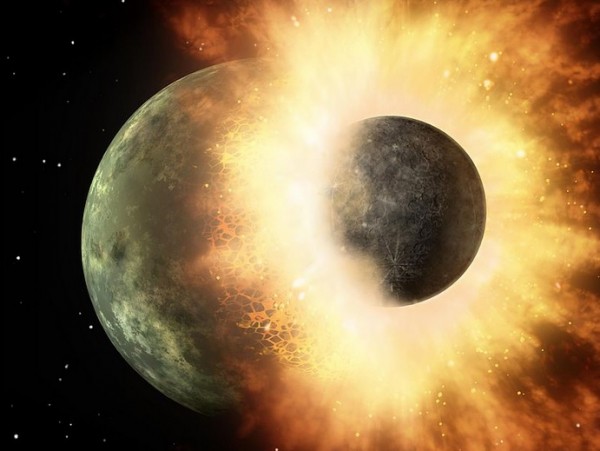Moon Formed from Earth's Twin Sister Planet Theia After Violent Collision
| Ana Verayo | | Apr 09, 2015 02:26 AM EDT |
(Photo : NASA/JPL-Caltech ) An impact such as this between the Earth and a Mars-sized object likely formed the Moon.
New research asserts the Moon was created after the Earth collided with its almost twin planet billions of years ago.
Astronomers and scientists have long believed the Moon was formed when the Earth smashed into another planetary body roughly the size of Mars. Scientists are now investigating how much of Earth's primordial twin was left as remnants on the Moon.
Like Us on Facebook
Computer simulations suggest this world that collided into infant Earth was most likely formed near our region in the solar system and with the same materials. After the formation of the Moon from that interplanetary collisions, both bodies were also simultaneously bombarded by similar collisions from relatively small protoplanets.
During those collisions, the planets were coated with material from these objects and Earth accumulated a thicker deposit.
Earth's twin and impactor called Theia collided into the Earth around 4.5 billion years ago. Estimated to be the size of Mars, Theia also possessed a mass equal to one tenth of our planet.
Computer simulations reveal this planetary collision resulted in our Moon having the same composition as the mantle of Earth. This is confirmed by evidence obtained from chemical compositions and observations from the lunar surface that the Moon's material is derived from the same material as our mantle.
Scientists determine the origins of planets and large asteroids in the solar system by the ratios found in their elements. Since the Moon is similar to the Earth's mantle, researchers also believe Theia was also formed in the same region in the solar system near the Earth.
Isotope ratios also reveal a variety of elements that have the same numbers of protons but different neutron content. These ratios reveal a significant deal of information about bodies in the solar system, especially the details of the early stages of their formation.
Even if the physics of the impact between Earth and Theia can be applied to observational data, isotopic analysis doesn't support this theory.
Researchers examined levels of isotopes in tungsten found on Earth and the Moon and they discovered both were similar to each other. Astronomers believe that the Moon has a different composition from Earth, containing higher concentrations of tungsten-182.
Richard Walker of the University of Maryland said the Earth and the Moon have very similar isotopic content formed from the same material during the solar system's infant stages. Theia is expected to have been different from Earth since it created the Moon, meaning the Earth and the Moon should have different chemical properties.
Scientists are now looking into how the Moon formed during an extremely violent phase in the solar system's history.
This study was published in the journal, Nature.
TagsMoon Originates from Earth's Twin Sister Planet Theia After Violent Collision, moon, Theia, Earth, moon earth twin sister planet collision, how the moon was formed
©2015 Chinatopix All rights reserved. Do not reproduce without permission
EDITOR'S PICKS
-

Did the Trump administration just announce plans for a trade war with ‘hostile’ China and Russia?
-

US Senate passes Taiwan travel bill slammed by China
-

As Yan Sihong’s family grieves, here are other Chinese students who went missing abroad. Some have never been found
-

Beijing blasts Western critics who ‘smear China’ with the term sharp power
-

China Envoy Seeks to Defuse Tensions With U.S. as a Trade War Brews
-

Singapore's Deputy PM Provides Bitcoin Vote of Confidence Amid China's Blanket Bans
-

China warns investors over risks in overseas virtual currency trading
-

Chinese government most trustworthy: survey
-

Kashima Antlers On Course For Back-To-Back Titles
MOST POPULAR
LATEST NEWS
Zhou Yongkang: China's Former Security Chief Sentenced to Life in Prison

China's former Chief of the Ministry of Public Security, Zhou Yongkang, has been given a life sentence after he was found guilty of abusing his office, bribery and deliberately ... Full Article
TRENDING STORY

China Pork Prices Expected to Stabilize As The Supplies Recover

Elephone P9000 Smartphone is now on Sale on Amazon India

There's a Big Chance Cliffhangers Won't Still Be Resolved When Grey's Anatomy Season 13 Returns

Supreme Court Ruled on Samsung vs Apple Dispute for Patent Infringement

Microsoft Surface Pro 5 Rumors and Release Date: What is the Latest?










